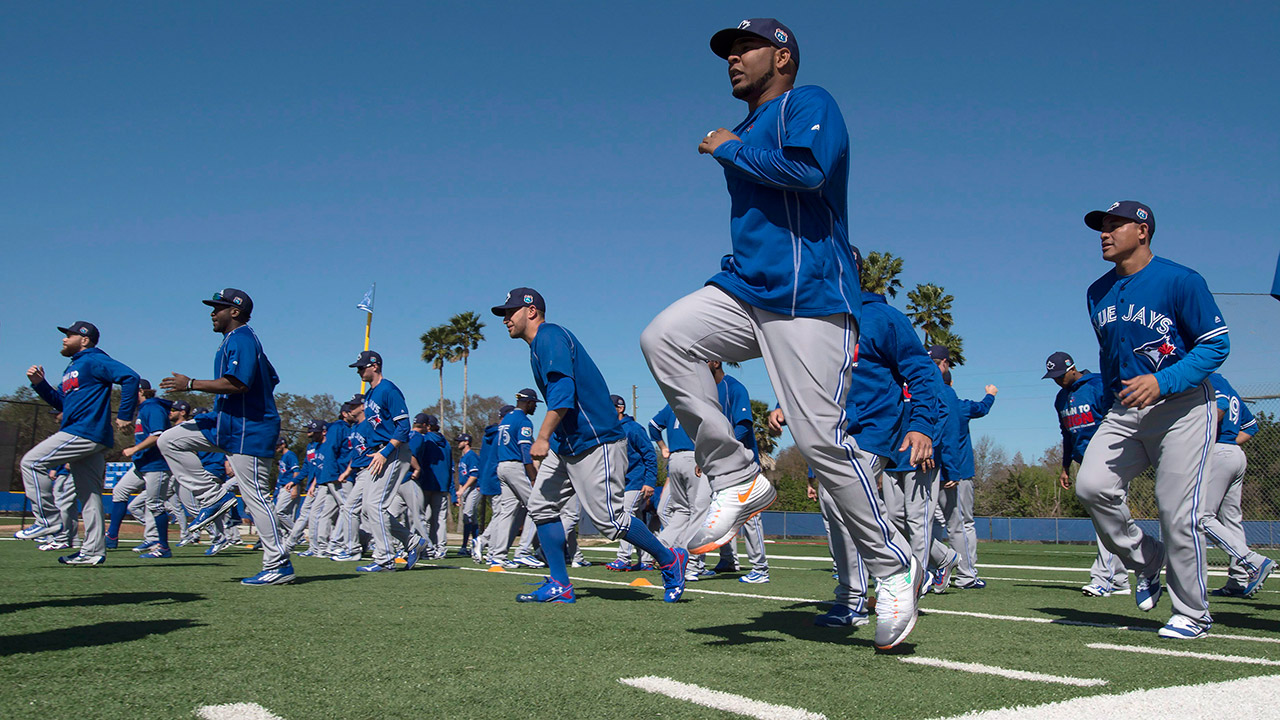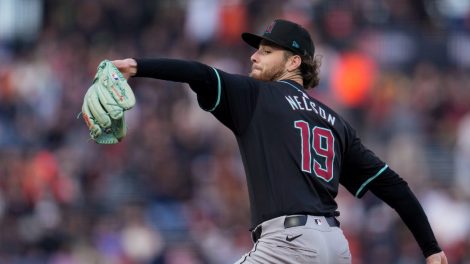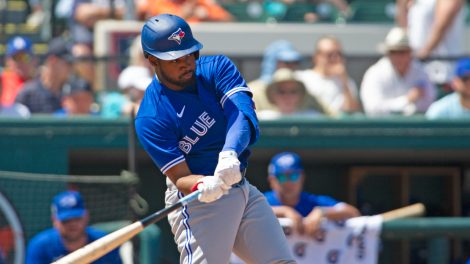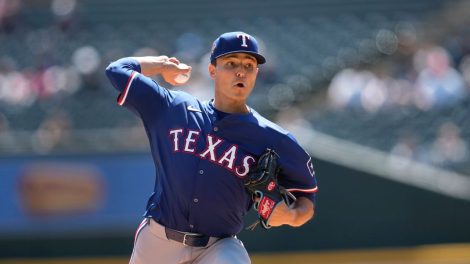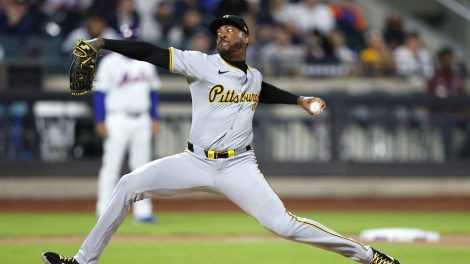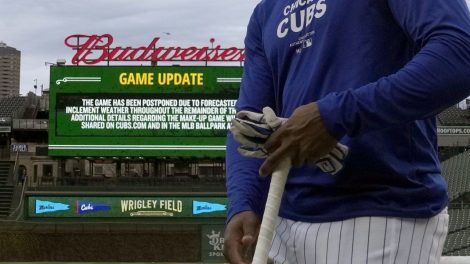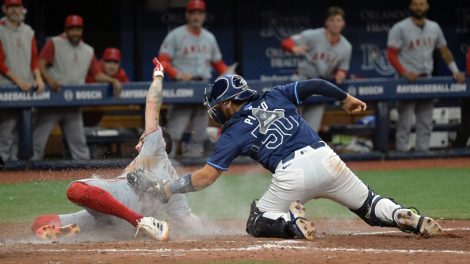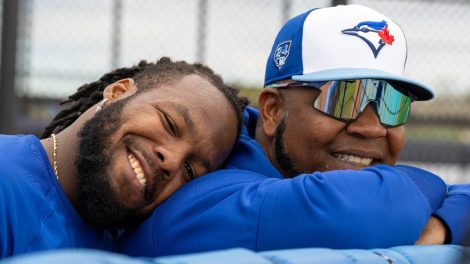DUNEDIN, Fla. — Angus Mugford is just a few months into his new job as the Toronto Blue Jays director of high performance and he’s already keeping a close eye on the most minute occurrences in his purview. He really doesn’t have a choice. That’s because Mugford’s office — deep in the heart of the winding maze that is Dunedin’s Bobby Mattick Training Center — is literally inside of a trainers’ room. As Mugford sits back in his chair, looking at a massive white board filled with scribbles in blue, black, red and green, he can peer out his office window and watch as a minor leaguer has his ankle examined a few feet away.
It’s from here that Mugford is currently overseeing the implementation of a completely new venture for the Blue Jays, one the club’s new President, Mark Shapiro, believes deeply in and hopes will give his team a competitive advantage for decades to come. The idea is to integrate all aspects of a player’s performance under one umbrella — from strength and conditioning, to nutrition, to mental health — and to tailor a specific plan for each and every player in the organization in order to establish their goals and give them every resource possible to achieve them. In other words, they’re trying to change the game.
“No one in baseball is really doing this the way we’re proposing to,” Mugford says. “We’re looking to really take it up a level and really invest in how we’re developing people.”
It’s a holistic performance design that is already being utilized in many major sports — especially at the national level with Olympic athletes — but has been slow to catch on in baseball, a game often detrimentally beholden to tradition. It flies in the face of the theory that ballplayers should conform to a franchise’s rigid guidelines for training and behaviour. Instead, it believes that the franchise’s resources should bend to the needs and character of each individual athlete.
The overarching framework of Mugford’s division is simple: Prepare, work, recover. Where it gets complicated is how those three factors filter into everything a player does, on the field and off. Every Blue Jay has his own unique set of needs, both physical and mental, and, with the help of data gathered over time, Mugford’s department will aim to tailor its development approach to those specifics. Not every pitcher will ramp up their arm at the same rate. Not every hitter will get the same number of at-bats during spring training. Not every athlete will work out the same way in the weight room or eat the same way in the dining hall. And certainly not every ballplayer will be expected to react uniformly to the psychological stresses of baseball.
Likewise, every player has their own desires for their career. Some want to hit for more power; some want to pitch 200 innings; some want to improve their range on defence. Those ambitions will be collected and challenged, and each player will end up with their own prioritized shortlist of goals, and a clear blueprint with steps they can take to achieve them based on their own individual physical and mental makeup. They will each have a data-driven plan for how they eat, sleep and train that helps optimize their recovery between games and between seasons. The ultimate goal, of course, is to get the absolute most out of players on the field and, in turn, to win.
“It’s a true collaboration,” Mugford says. “The player’s always to be at the centre of it, so that they take ownership over their career, so that they have a voice, and so that they’re sharing what their goals are. And then, with our team around them, we can help decide how best to go about achieving those goals and what’s going to be best for the player’s long-term career.
“I hope one of the messages the players have been receiving is: How can we help you get better? How can we support you? How can we help you be at your best?”
—
Mugford comes to the Blue Jays from the revered IMG Institute where he spent 12 years working with a bevy of professional athletes from every sport you can think of. His mentor, Charlie Maher, was one of the first people to introduce sports psychology into baseball and has worked with Shapiro’s Cleveland Indians since 1995. When Shapiro was looking for someone to quarterback his high performance vision in Toronto he called Maher, who made the connection. It wasn’t long before the Blue Jays president made Mugford “an offer I couldn’t possibly say no to.”
“Mark is just an amazing leader. He has this great vision for doing things differently than how they’ve been done in baseball to this point,” Mugford says. “And he was fascinated by what we were doing at IMG, not just on the athlete development side, but with our development of coaches and military, too.”
Mugford is well travelled and has worked with everyone from rugby’s New Zealand All Blacks to the American military’s Special Operations Forces. In Mugford’s mind, there’s little difference between what Jose Bautista does standing at the plate in the seventh inning of Game 5 of the ALDS, and what a US Navy SEAL does when conducting a search and rescue operation in a war zone. The outcomes — home run and strike out vs. life and death — are incredibly different, but the preparation processes aren’t. “We call it high performance,” Mugford says, “but it’s really human performance.
“In that pressure moment for a baseball player where you know that the weight of the world’s on your shoulders, it may feel like life and death,” he continues. “In that moment, your biology does the talking. Your brain interprets the situation and activates an adrenaline response. And whether you view that situation as a threat or a challenge is a biological thing. The best performers in those situations — whether you’re an ER doctor or a solider or a baseball player — aren’t focused on the life and death outcome. They’ve trained so well that they’re able to focus on the task at hand and the process. That’s what we want our players to be able to do when they know the World Series is on the line.”
A big appeal of the Blue Jays job for Mugford is the fact that professional baseball lends itself to development more than arguably any other sport on the planet. In hockey, football and basketball, it’s not uncommon for athletes to reach the highest level of their sport a year or two after they’re drafted, with the most elite talents going straight from the draft floor to the pros. But consider Aaron Sanchez, who the Blue Jays drafted in the first round as a 17-year-old in 2010 and have slowly progressed on a nine-stop journey through the minor leagues. Just now, after six years of grooming and development, the talented right-hander is competing for a spot in the major league rotation.
What also excites Mugford is the pure depth of baseball talent in North America. Much of his work has focused on less popular sports or smaller countries that have had to focus intensely on developing the limited talent they have available to them. With more than 1,200 players selected every year in the MLB draft, baseball doesn’t have that problem. Mugford feels that if he can apply some of the development principles he’s used in shallower athletic pools to the sheer volume of natural talent available to the Blue Jays, he can create something special.
“We’re almost spoiled for talent, where if a guy doesn’t work out, someone else is following in their footsteps,” Mugford says. “So, if we can get the best of both worlds, where we already have great talent, and then we really maximize the potential and the development of those players we have — that’s big. That’s how we make the Blue Jays the organization that everybody wants to work for, whether you’re a player, a coach or a staff member.”
—
So far, Mugford has built a high performance department of a dozen people, with specialists dedicated to everything from sports science to mental performance to an employee assistance program, which has professionals on hand ready to address the mental health of Blue Jays players in much the same way physical therapists would tend to their ankles and knees. They work in close concert with Gil Kim’s player development team, which focuses more on the nuts and bolts of pitching mechanics on the mound and hitting approaches at the plate.
One of the first tangible effects of the new approach that fans may have noticed is Jose Bautista’s approach in Dunedin. The veteran slugger has been sticking to a highly specialized training schedule since the turn of the new year and won’t take his first spring training at-bats until Thursday afternoon in Tampa, 10 games into the team’s Grapefruit League schedule. Blue Jays manager John Gibbons has traditionally believed that hitters should see around 60 plate appearances during spring training in order to best find their timing before the season, but the high performance department had other plans for Bautista.
“These guys have a lot of expertise. They’ve been involved in a lot of different sports and they’ve got some pretty good ideas,” Gibbons says. “And for a guy like Jose, it’s really perfect for him.”
Bautista’s commitment to physical maintenance is legendary. He’s been working with his own high performance specialists for years and has often invited fellow Blue Jays down to Florida well before spring training begins to work out under the guidance of his team of professionals. Shapiro says Bautista “treats his body like a Fortune 500 company” (that’s part of the reason why the 35-year-old is reportedly making such substantial demands during negotiations on a new contract). Now he’s being given the opportunity to do that in-house instead of on his own.
“I have nothing but praise for everything they’ve done here so far,” Bautista says of the high performance initiative. “They’re taking care of the players as athletes and making sure they have the proper food, the proper equipment, the proper technology to help them be better players on the field when the game starts. That’s something that I’ve never experienced before and I applaud them for it.”
Josh Donaldson, the reigning AL MVP who’s played 158 games for three straight seasons and takes great pride in his durability, agrees.
“I don’t understand why more teams don’t do this,” the 30-year-old says. “You have guys who are elite athletes. They need to be trained properly; they need to eat properly.
“Everybody talks about five tools in baseball. In my opinion, there’s really six. The sixth tool is being able to stay on the field. Because if you have five tools but you aren’t able to go out there and play, what does it matter?”
You need not look any further than the Blue Jays opening day starter to see how impactful this approach can be. When Marcus Stroman tore his ACL during spring training last season, he started brainstorming plans to rehab and finish his sociology degree at Duke University while he sat in the doctor’s office waiting for the results of his MRI. He brought his plans to the Blue Jays, who were more than happy to allow Stroman to rehab outside their facilities. That’s primarily because Dr. Robert J. Butler, a consulting doctor with the team who specializes in recovery from ACL reconstruction, works at Duke, but also because the Blue Jays didn’t even have a physical therapist on staff.
Butler and his team took a data-driven approach to Stroman’s rehabilitation, utilizing technology like the Omegawave and Catapult systems to measure the pitcher’s progress and determine the 24-year-old’s preparedness to advance his recovery. There was no schedule, no timetable that said Stroman could do this in Week 3 and that in Week 4. When he was ready to move forward, he did. And the end result was Stroman returning from his injury in less than six months and pitching important games for the Blue Jays down the stretch and into the playoffs. If he’d followed traditional ACL recovery protocols, Stroman would have never pitched those games.
“One of the most important things I look at is challenging the status quo. Asking questions about why we train a certain way, and making sure there’s a strong rationale and an evidence-based approach to everything,” Mugford says. “Marcus and the Duke team are a great example of delivering on that.”
One of the physical therapists who worked daily with Stroman at Duke, Nikki Huffman, is now a part of Mugford’s staff with the Blue Jays. He’s also brought in a fellow Brit with an extensive strength and conditioning background, Clive Brewer, to be his assistant director, a move Mugford calls a “game-changer.”
“Clive’s expertise comes out of the sports science space. He’ll help us be a lot more informed when it comes to what kind of recovery players need and optimizing that recovery on an individual level,” Mugford says. “Recovery is massive for baseball players. These guys play 162 games in 184 days. It’s a mind-blowing thing to me. It’s insane.”
—
Of course, none of this will happen overnight. Blue Jays fans may not see noticeable benefits of a program like this until half a decade from now, as players the team drafts in the coming years begin to make an impact at the major league level. Mugford’s department can certainly have an influence on current players in the organization (such as Devon Travis, who has been working closely with Huffman as he recovers from shoulder surgery), but it’s the athletes who will enter the fold not knowing any other approach but this one who will benefit the most.
In the coming years there will also be significant improvements made to the department’s infrastructure in Dunedin — or potentially elsewhere if the team can’t work out a deal with the town that’s hosted its spring training since 1977. The Blue Jays current facilities are woefully outdated (Shapiro calls them “charming”) and thorough modernization is currently being arranged, which will give Mugford and his staff much more room to operate.
Whichever form those renovations end up taking, you can be sure that Mugford’s departmental needs will be right at the heart of it. New rehab space, new equipment, new technology — and maybe even a new office for the high performance director, with a better view than his current one of a trainer’s table.
“It’s early days,” Mugford says, looking at a sprawling directory of headshots and names taped to his office wall, a periodic table of every player in the organization. “But the five-year vision is hugely exciting. There’s so much opportunity and potential. It’s such a new and different thing for baseball. I think, and in some respects I hope, that this could change the game.”

